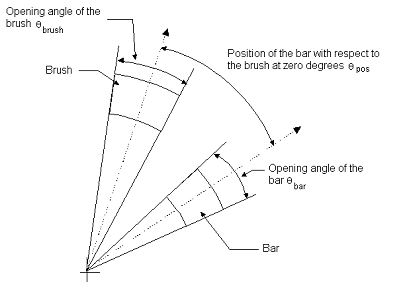Component for rotating machines: brush-segment
Brush-segment
The brush-segment component is a switch describing the electrical contact between a segment of the commutator segment and the brush in a D.C. machine.
Utilization
This component is used in transient applications and requires the use of kinematic coupling.
Brush-segment: characteristics
The brush-segment component is characterized by five parameters:
- the on state resistance Ron in Ohms
- the off state resistance Roff in Ohms
- the angular position of the commutator segment with respect to the brush position θpos in degrees
- the brush opening angle θbrush in degrees
- the opening angle of the commutator segment θbar in degrees

Brush-segment: operation
Conductance of brush-segment component (negative θpos).
The brush-segment component is in full conduction whenever the mechanical angle of the rotor (θmec) is opposite to the angular position of the commutator segment with respect the brush (θpos).
Thus, we have conduction of the brush-segment starting from θmec = θpos
Description of a commutator
To define the commutator of an electrical machine that includes N brushes and M commutator segments, it is necessary to connect each brush to the M commutator segments. Thus, it is necessary to create N*M brush-segments components.